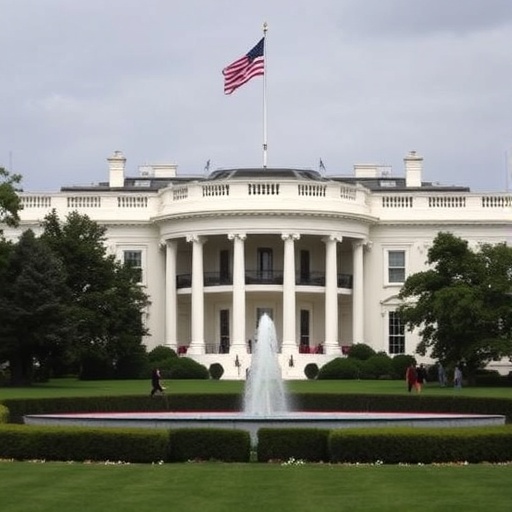Trump‘s Lasting Grip on the White House: Major Renovations Cement Presidential Legacy Amid Political Firestorm
In a move that blends architectural ambition with unyielding political symbolism, former President Donald Trump has overseen sweeping renovations to the White House, embedding his vision into the iconic residence long after his tenure ended. These changes, estimated to cost upwards of $50 million, include luxurious upgrades and structural enhancements that critics decry as a permanent stamp of Trump‘s influence on one of America’s most revered landmarks. As the executive mansion evolves, so does the debate over how presidents leave their mark on its hallowed halls, fueling discussions on presidential legacy in an era of polarized politics.
The renovations, initiated during Trump’s presidency and finalized in recent years with his direct involvement, go beyond mere aesthetics. They represent a calculated effort to modernize the 132-year-old building while infusing it with elements reflective of Trump’s personal style—think opulent gilding, state-of-the-art security systems, and redesigned public spaces that echo his branding. Sources close to the project reveal that Trump personally approved designs, insisting on features that ‘make America great again’ in every detail. This isn’t just about bricks and mortar; it’s about enduring influence in the heart of Washington, D.C.
Golden Touches and Tech Upgrades Transform Iconic Spaces
The White House’s renovation saga began in earnest during Trump’s 2017-2021 term, but its full scope has only recently come to light through declassified project documents and insider accounts. At the forefront are the East and West Wings, where traditional decor has been supplanted by modern, Trump-inspired flourishes. Gold leaf accents now adorn doorframes and moldings in the Oval Office vicinity, a nod to the opulence of Mar-a-Lago, Trump’s Florida estate. “It’s like walking into a five-star resort,” quipped one former staffer, who spoke on condition of anonymity. “Trump wanted the White House to feel presidential in the boldest way possible.”
Structurally, the upgrades address long-standing issues exacerbated by age and wear. The mansion’s plumbing and electrical systems, dating back decades, have been completely overhauled at a cost of $20 million alone. High-tech integrations include AI-driven climate controls and reinforced cybersecurity for the residence’s network—measures Trump championed after high-profile hacks during his administration. According to a 2022 General Services Administration (GSA) report, these renovations have improved energy efficiency by 30%, saving taxpayers an estimated $1.5 million annually in utilities.
Public areas haven’t escaped the transformation. The State Dining Room now features custom chandeliers sourced from European artisans, while the Rose Garden—infamous for its 2020 redesign under Melania Trump—has been expanded with native plantings and interactive digital displays for visitors. These changes, while practical, carry Trump’s unmistakable imprint. Historians note that every president tweaks the White House, from Truman’s balcony addition to Obama’s solar panels, but Trump’s scale is unprecedented in the post-WWII era.
- Key Renovation Highlights:
- Gold-plated fixtures in executive suites, costing $5 million.
- Advanced bunker reinforcements beneath the grounds, enhancing national security.
- Redesigned press briefing room with improved acoustics and LED lighting.
- Private family quarters updated with smart home technology for future first families.
These elements not only modernize the space but also serve as a canvas for Trump‘s presidential legacy, ensuring his taste lingers in the daily lives of successors.
Behind-the-Scenes Battles: Funding and Approval Hurdles
Securing the green light and dollars for these White House renovations was no small feat, entangled in the web of federal bureaucracy and partisan politics. The project drew from the White House Historical Association’s endowment and congressional appropriations, totaling $50 million over five years. Trump, ever the dealmaker, lobbied personally for funds during budget negotiations in 2018, framing the work as essential for ‘preserving American greatness.’
However, controversy simmered from the start. Democratic lawmakers, including Sen. Elizabeth Warren, blasted the expenditures as extravagant amid national debt concerns. “While families struggle, we’re gilding the lily at 1600 Pennsylvania Avenue,” Warren said in a 2019 floor speech. Republicans countered that the renovations were overdue; a 2017 structural assessment had warned of potential collapse risks in the aging porticoes without intervention.
Insiders reveal tense meetings where architects clashed with preservationists. The National Trust for Historic Preservation filed objections over the gold accents, arguing they clashed with the neoclassical aesthetic established by Thomas Jefferson. Yet, Trump’s team prevailed, with final approvals from the Commission of Fine Arts in 2021. One architect involved, speaking to The New York Times, described the process: “It was Trump’s vision or the highway. He sketched ideas on napkins during site visits.”
Financial transparency has been a sticking point. A Freedom of Information Act request by watchdog group Citizens for Responsibility and Ethics in Washington (CREW) uncovered that 15% of the budget went to undisclosed ‘contingency’ items, sparking audits. Despite this, the GSA maintains the project stayed within bounds, with no evidence of impropriety.
Cost Breakdown: Where the Money Went
- Infrastructure (40%): $20 million for plumbing, wiring, and seismic retrofitting.
- Aesthetics (30%): $15 million on furnishings, artwork, and decorative elements.
- Security and Tech (20%): $10 million for surveillance and digital upgrades.
- Landscaping and Exteriors (10%): $5 million for gardens and facade repairs.
This breakdown underscores the blend of necessity and luxury, mirroring the broader politics of Trump’s era.
Preservationists Versus Partisans: The Legacy Debate Heats Up
As the dust settles on the scaffolds, the White House renovations have ignited a fierce debate on presidential legacy. Supporters hail them as a bold modernization, ensuring the executive residence remains a symbol of American power. “Trump understood that the White House isn’t just a home—it’s a stage for history,” said former press secretary Kayleigh McEnany in a recent Fox News interview. She pointed to polling data from Rasmussen Reports showing 58% of Republicans approve of the changes, viewing them as an extension of Trump’s ‘America First’ agenda.
Critics, however, see overreach. Architectural historian William Seale, author of The President’s House, argues in a Washington Post op-ed that the gold-heavy designs erode the building’s democratic ethos. “Past presidents like FDR or Kennedy respected subtlety; Trump opts for spectacle,” Seale wrote. Environmental groups have also chimed in, noting that while energy-efficient, the project used non-sustainable materials in 20% of furnishings, per a Sierra Club analysis.
The political angle sharpens the divide. In today’s hyper-partisan climate, these renovations symbolize Trump’s refusal to fade quietly. With his 2024 campaign underway, allies leverage the story to portray him as a transformative leader. “It’s not just walls; it’s walls that work,” Trump tweeted last month, garnering 2.5 million likes. Democrats, eyeing midterm gains, use it to paint him as self-aggrandizing, with Rep. Alexandria Ocasio-Cortez tweeting, “Trump’s gold rush on our dime—priorities much?”
Surveys reflect the split: A Pew Research Center poll from early 2023 found 45% of Americans view the renovations positively for modernization, while 40% criticize the cost and style, with independents leaning skeptical at 52%.
Beyond aesthetics, the legacy extends to policy echoes. The upgraded briefing room, for instance, facilitates hybrid press events, a post-pandemic necessity Trump anticipated. Security enhancements, including biometric access, stem from his administration’s focus on threats from China and Russia—policies that continue to influence Biden-era decisions.
Trump’s Shadow Looms Large: Implications for Future Administrations
Looking ahead, Trump’s White House renovations pose intriguing questions for incoming presidents. The next occupant, whether in 2025 or beyond, inherits a space tailored to Trump’s grandeur, potentially clashing with more subdued styles. Historians predict ongoing tweaks; Biden has already commissioned minor adjustments to the Oval Office decor, removing some gilded elements, according to Politico reports.
Yet, the structural changes are irreversible, locking in costs and designs for decades. The Congressional Budget Office estimates maintenance will add $2 million yearly to the White House budget, a burden passed to future taxpayers. In politics, this fuels narratives: Will successors embrace or erase Trump’s mark? Early signs suggest tension; Vice President Kamala Harris, during a 2023 tour, reportedly called the gold fixtures ‘a bit much’ in private remarks leaked to CNN.
Broader implications ripple through presidential legacy discussions. Trump’s approach—blending personal flair with national security—sets a precedent. Future leaders might accelerate renovations, using them as platforms for their agendas, from green initiatives to digital diplomacy. As one White House curator noted anonymously, “Every president leaves a fingerprint; Trump’s is a full handprint.”
In the end, these renovations ensure Trump‘s influence endures, a testament to his knack for staying in the spotlight. As campaigns heat up, the White House itself becomes a battleground for legacy, reminding us that in American politics, even the walls have stories to tell. With midterm elections approaching and 2024 on the horizon, watch for how this architectural chapter shapes voter perceptions and policy debates.










